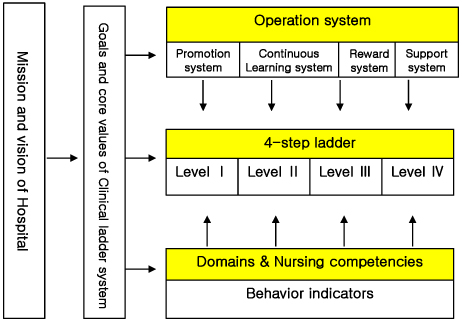J Korean Acad Nurs Adm.
2011 Sep;17(3):301-314.
Development of a Clinical Ladder System for Operating Room Nurses
- Affiliations
-
- 1Chonnam National University Hospital, Korea.
- 2College of Nursing, Chonnam National University; Chonnam Research Institute of Nursing Science, Korea. jangks@chonnam.ac.kr
Abstract
- PURPOSE
This study was a methodological research conducted to develop a clinical ladder system for operating nurses.
METHODS
Participants were 20 OR nurses, working in C Hospital, who had a mean tenure of 6 years and 10 months. Data collection consisted of 4 focus group interviews during May and June 2009. The content analysis method of Kim and Lee (1986) was used to analyze the data. Two clinical expert groups consisting of 16 nurses verified the content validity of the preliminary system from September 16 to 26, 2009 using Kim's tool (1999).
RESULTS
The final clinical ladder system consisted of goals, core values, and 4 domains of practice related to core values, which were defined as professional value, perioperative nursing practice, education/research, and collaboration/leadership. Eleven nursing competencies and 44 behavior indicators were included in accordance with the 4-step ladder. The 4 operation systems for the clinical ladder system were the promotion system, continuous learning system, reward system, and support system.
CONCLUSION
The results indicate that nursing managers need to pay more attention to developing a clinical ladder system for nurses.
Keyword
MeSH Terms
Figure
Reference
-
1. Benner P. From novice to expert: Excellence and power in clinical nursing practice. 1984. California: Addision-Wesley Pub.2. Drenkard K, Swartwout E. Effectiveness of a clinical ladder program. J Nurs Adm. 2005. 35(11):502–506.
Article3. Fusilero J, Prohaska P, Szweda C, Carney K, Mion LC. The career advancement for registered nurse excellence program. J Nurs Adm. 2008. 38(12):526–531.
Article4. Goodloe LR, Sampson RC, Munjas B, Whitworth TR, Lantz CD, Tangley E, et al. Clinical ladder to professional advancement program: An evolutionary process. J Nurs Adm. 1996. 26(6):58–64.5. Goodrich CA, Ward CW. Evaluation and revision of a clinical advancement program. Medsurg Nurs. 2004. 13(6):391–398.6. Gustin TJ, Semler JE, Holcomb MW, Gmeiner JL, Brumberg AE, Martin PA, et al. A clinical advancement program: creating an environment for professional growth. J Nurs Adm. 1998. 28(10):33–39.7. Jang KS. A study on establishment of clinical career development model of nurses. 2000. Seoul: Yonsei University of Korea;Unpublished doctoral dissertation.8. Jang KS, Choi JY. Reengineering and integrated strategy of management in nursing. Chonnam J Nurs Sci. 1997. 2(1):185–206.9. Jung SW. A survey on the recognition of RNs about the adoption of the clinical ladder system. Korean Nurse. 2005. 44(6):69–82.10. Kim GD, Lee OJ. Method of social survey research - Logic and technique of social study -. 1986. Seoul: Paryoungsa.11. Kim HG. Developing evaluation systems for career development programs. Korean J Hum Res Dev. 1999. 1(2):183–214.12. Kim HG. Theory and practice of career development. 2000. Seoul: Dasan.13. Knowles BW. The development of a career ladder for acute care case managers. Prof Case Manag. 2008. 13(6):331–337.
Article14. Korean Hospital Nurses Association. Hospital nurses staffing state survey. 2007. Retrieved September, 2009. from http://www.khna.or.kr/bbs/linkfile/2007/khna_070216.pdf.15. Korean Hospital Nurses Association. Hospital nurses staffing state survey. 2009. Retrieved September, 2009. from http://www.khna.or.kr/bbs/linkfile/2009/khna_090223.pdf.16. Kravutske ME, Fox DH. Creating a registered nurse advancement program that works. J Nurs Adm. 1996. 26(11):17–22.
Article17. Krugman M, Smith K, Goode CJ. A clinical advancement program: Evaluating 10 years of progressive change. J Nurs Adm. 2000. 30(5):215–225.18. Kwon IG, Sung YH, Park KO, Yu OS, Kim MA. A study on the clinical ladder system model for hospital nurses. Clin Nurs Res. 2007. 13(1):7–23.19. Lacey SR, Teasley SL, Henion JS, Cox KS, Bonura A, Brown J. Enhancing the work environment of staff nurses using targeted interventions of support. J Nurs Adm. 2008. 38(7-8):336–340.
Article20. Lewis CK. The clinical nurse specialist's role as coach in a clinical practice development model. J Vasc Nurs. 1996. 14(2):48–52.
Article21. Loyola University Health System. Nursing Clinical Ladder, Chicago. Retrieved 10 August 2009. from http://loyolamedicine.org/Nursing/Career/upload/Nursing-Clinical-Ladder-05.ppt.22. Nelson JM, Cook Pf. Evaluation of a career ladder program in an ambulatory care environment. Nurs Econ. 2008. 26(6):353–360.23. Nelson J, Sassaman B, Philips A. Career ladder program for registered nurses in ambulatory care. Nurs Econ. 2008. 26(6):393–398.24. Park SH, Park KO, Park SA. A development of career ladder program for nurse in a hospital. J Korean Acad Nurs Adm. 2006. 12(4):624–632.25. Riley JK, Rolband DH, James D, Norton HJ. Clinical ladder: Nurses' perceptions and satisfiers. J Nurs Adm. 2009. 39(4):182–188.26. Schmidt LA, Nelson D, Godfrey L. A clinical ladder program based on Carper's fundamental patterns of knowing in nursing. J Nurs Adm. 2003. 33(3):146–152.
Article27. Shirey MR. Competencies and tips for effective leadership: From novice to expert. J Nurs Adm. 2007. 37(4):167–170.28. Trinity Hospitals. Clinical Ladder program. Retrieved 10 August 2009. from http://www.trinityhealth.org/ladders/pdf/Introduction.pdf.29. University of Michigan Health System. UMPNC/UM Management Joint Contract Implementation Team Clinical Ladder Standards and Measurements. Retrieved 10 August 2009. from http://www.med.umich.edu/nursing/jit/docs/forms/clinladder.pdf.30. Winslow SA, Blankenship J. Mentoring clinical ladder advancement with a facilitated prep class. J Nurses Staff Dev. 2007. 23(4):180–182.
Article
- Full Text Links
- Actions
-
Cited
- CITED
-
- Close
- Share
- Similar articles
-
- Establishing a Clinical Ladder System for Nurses in a Small and Medium-sized Hospital
- The Impact of Clinical Competence and Perception of Clinical Ladder System on Organizational Commitment among Nurses at a General Tertiary Hospital
- Clinical nurses’ experience of participating in a career ladder system: A qualitative study using focus group interviews
- Organizational Socialization and Intention to Leave in Operating Room Nurses Working at Secondary General University Hospitals
- Effect of Perception of Career Ladder System on Job Satisfaction, Intention to Leave among Perioperative Nurses



